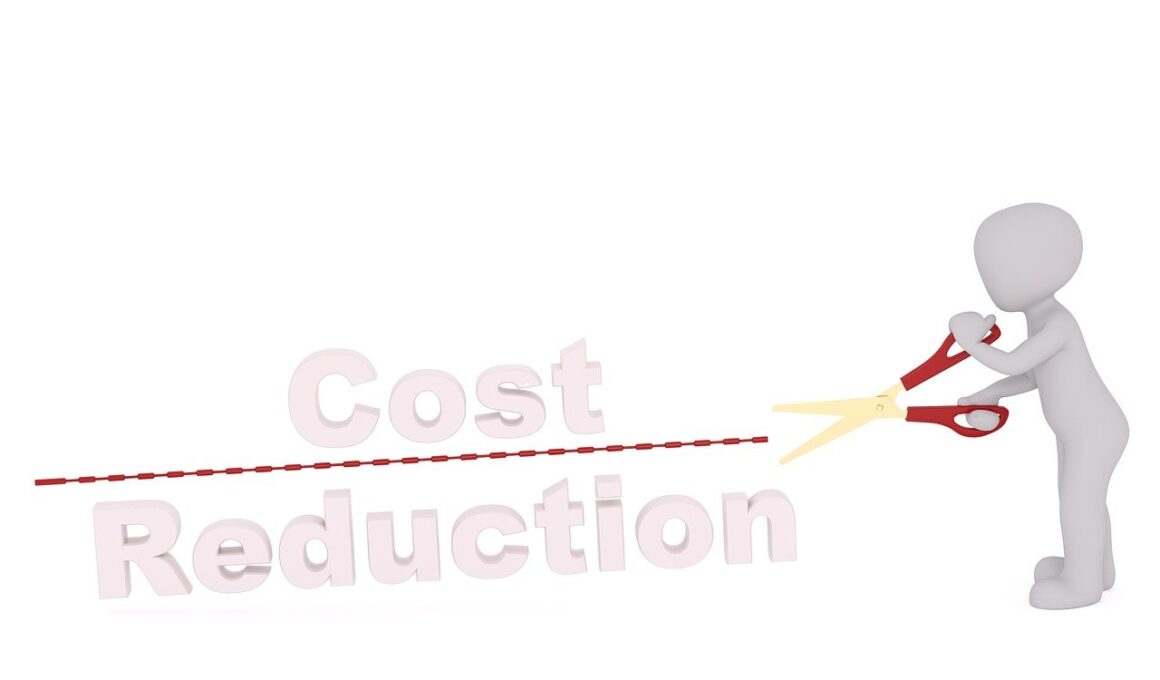Using Benchmarking to Identify Cost Saving Opportunities
Benchmarking is a crucial strategy in cost accounting that helps organizations identify areas for cost reduction. By comparing operational performance and processes with recognized industry standards or direct competitors, businesses can pinpoint inefficiencies. The primary goal of benchmarking is to ascertain best practices that lead to improved performance. The process entails setting measurable goals based on existing data and continuously monitoring operations to achieve them. Additionally, engaging stakeholders at all levels is essential; management must align with employees on objectives. Performance metrics derived from benchmarking include cycle time, quality, and productivity rates. These considerations can illuminate paths toward greater efficiency and cost effectiveness. An effective benchmarking process can involve several steps: planning the benchmarking approach, engaging with industry peers, gathering relevant data, analyzing findings, and devising implementation strategies. Furthermore, evaluating the results against defined targets is crucial for continual improvement. Organizations can use reports and dashboards to visualize progress and motivate teams toward achieving these cost-saving objectives. In conclusion, by systematically applying benchmarking principles, companies can uncover substantial opportunities for reducing costs and enhancing overall operation efficiency.
After identifying benchmark metrics, the next logical step involves developing a detailed action plan. This plan should outline how to close the gaps identified during the benchmarking process. Once the benchmarks have been established, organizations can prioritize which areas need immediate attention. Cost-saving opportunities are often found in redundant processes, outdated technologies, or ineffective resource allocation. Aligning workforce capacity with these insights is essential; training staff to adopt best practices can significantly impact performance. In addition, utilizing technology to automate repetitive tasks can lead to substantial cost reductions while increasing accuracy. Regularly refining the action plan based on continual feedback helps maintain the momentum for change. Employing a project management approach can ensure the plan remains on track. For instance, using Gantt charts or Kanban boards can improve visibility and accountability among team members. Moreover, establishing a cross-functional team dedicated to implementing changes promotes accountability and shared ownership of the process. Consistent communication is vital throughout this initiative. Regular meetings to discuss progress, challenges, and insights derived from the implementation can help keep everyone aligned and motivated. Ultimately, adapting the plan based on performance outcomes fosters a culture of continuous improvement and cost awareness among teams.
Choosing the Right Benchmarking Partners
Choosing appropriate benchmarking partners is instrumental for effective cost reductions. Collaborating with peers or industry leaders who have a proven track record can provide significant insights into effective practices. Organizations should consider several factors when selecting partners for benchmarking. First, the partner’s scale, industry, and operational structure should closely resemble those of the organization to ensure the relevance of the findings. Sharing experiences and data with partners fosters a learning environment where both parties can benefit. Additionally, the credibility of the benchmarking partner is paramount; partners should have established reputations in the field to ensure that the shared data is reliable. Communicating openly about results, strategies, and challenges with partners can open up new avenues for exploring cost savings. Regular updates and feedback loops are essential for maximizing the relationship, allowing for dynamic adjustments based on evolving industry standards. Leveraging technology such as online platforms or collaborative tools can facilitate these interactions, making data sharing straightforward and efficient. Lastly, maintaining relationships with multiple partners can provide diverse perspectives, enhancing the overall benchmarking process and keeping organizations ahead in adopting innovative cost-reducing strategies.
The data collected from benchmarking should be meticulously analyzed to yield meaningful insights. Analysis techniques, such as trend analysis, variance analysis, or root cause analysis, can support identifying specific cost areas that require attention. Identifying patterns in performance data can reveal opportunities for improvement as well. Collaborative discussion of the findings within cross-functional teams encourages a comprehensive understanding of cost structures. Additionally, harnessing software tools and analytics platforms enhance the analysis capabilities by presenting complex data in easily digestible formats. Dashboards can visualize key metrics, making it easier for stakeholders to grasp the situation quickly. Moreover, this visibility fosters a shared understanding of current operations and promotes a unified approach toward reducing costs. Setting benchmarks also necessitates the establishment of clear definitions for each metric to avoid ambiguity during analysis. By distinguishing what constitutes best practices clearly, organizations can evaluate whether their performance aligns with their strategic goals. Continual refinement of these benchmarks ensures they remain relevant as the industry evolves. Integrating these insights into strategic planning can shape future decisions, leading to even greater cost efficiencies and aligning operational practices with market realities.
Implementing Cost Reduction Strategies
After thoroughly analyzing benchmarking data, organizations are ready to implement targeted cost reduction strategies. This phase necessitates strong leadership and clear communication to ensure all team members understand the urgency and significance of these changes. Developing a comprehensive communication plan will facilitate successful implementation, ensuring everyone is aligned on goals and motivations behind these initiatives. Deploying pilot programs can provide valuable insights and test the effectiveness of new strategies before full-scale implementation. Furthermore, engaging employees through training and workshops can improve morale and adaptability. The strategies may encompass various changes such as revising supplier contracts to achieve better terms, optimizing logistics and supply chains, or reevaluating service contracts for potential savings. Additionally, organizations might explore energy efficiency initiatives or assess their facilities for potential operational savings as well. Regular progress reports to the leadership and stakeholders keep everyone informed and engaged in the ongoing process. Meanwhile, soliciting feedback allows for ongoing adjustments throughout implementation. Initially uncomfortable adjustments may ultimately become beneficial long-term changes. Celebrating small wins along the way fosters an atmosphere of motivation and recognition, reinforcing the commitment to achieving greater operational efficiency and cost reduction.
As cost reduction strategies take shape, measuring their effectiveness becomes necessary to assess the overall success of initiatives. Utilizing key performance indicators (KPIs) enables organizations to gauge whether the implemented strategies are delivering the desired outcomes. These KPIs may include metrics related to cost per unit, operational efficiency improvement, and time savings achieved. Tracking these indicators continuously encourages accountability at all levels and provides a clear picture of progress. Regularly reviewing these outcomes against established benchmarks facilitates identifying any deviations or areas needing further optimization. Annual performance reviews can reveal historical success while pinpointing unforeseen challenges faced during implementation. This reflective practice empowers organizations to adapt their strategies in real-time, laying a foundation for continuous improvement. Furthermore, sharing success stories and insights across departments can inspire a broader commitment to a culture of efficiency. Documenting lessons learned during this process provides a valuable resource for future initiatives. Engaging in retrospective discussions helps teams evaluate what strategies yielded significant cost reductions and what hurdles impeded progress. Formal case studies provide comprehensive insights and equip teams with knowledge to support further cost-saving endeavors down the road.
The Future of Benchmarking in Cost Accounting
The landscape of cost accounting is continuously evolving, with benchmarking playing an increasingly vital role in guiding strategic decisions. As organizations embrace digital transformation and innovative technologies, benchmarking methodologies must adapt accordingly. Integrating advanced analytics and artificial intelligence into the benchmarking process can yield deeper insights and enhance decision-making. These technologies can streamline data collection, ensuring that organizations are equipped with the most accurate and timely information possible. Through predictive analytics, businesses can forecast potential cost escape scenarios before they arise, enabling proactive decision-making. Moreover, the growing trend of agile management encourages iterative benchmarking processes that align with rapidly changing market conditions. Cross-industry benchmarking is emerging as another avenue, allowing organizations to draw inspiration from various sectors. Learning from industries outside their own can foster creativity and open new pathways for efficiencies. Commitment to continuous improvement and adaptation will further entrench benchmarking as an essential practice within cost accounting. Engaging the entire organization in this process cultivates an innovative culture where all employees contribute toward optimizing operational performance. Embracing future trends will solidify benchmarking’s role as a crucial factor in strategic success and operational excellence.
In summary, utilizing benchmarking to identify cost-saving opportunities is a dynamic and transformative journey for organizations. By engaging in this systematic process, businesses can uncover inefficiencies, optimize operations, and create strategies that lead to substantial cost savings. The foundation of successful benchmarking lies in selecting suitable partners, gathering accurate data, and implementing actionable insights derived from thorough analyses. Following through with an adaptive action plan ensures that organizations remain focused on their goals while fostering a culture of continuous improvement. Emphasizing employee engagement and open communication transforms the implementation process, making it a team effort that enhances morale and accountability. As companies continue to integrate advanced technologies and analytics into their benchmarking processes, they position themselves to sustain their competitive advantage. The future of cost accounting is bright, with benchmarking fostering innovation and strategic thinking. Continually refining these processes while learning from successes and challenges allows businesses to drive sustainable efficiency. Ultimately, this journey is not just about reducing costs but about enhancing overall organizational performance, ensuring long-term viability and success in an ever-evolving marketplace. Organizations that commit to this path will undoubtedly thrive in their efforts to innovate and excel.


